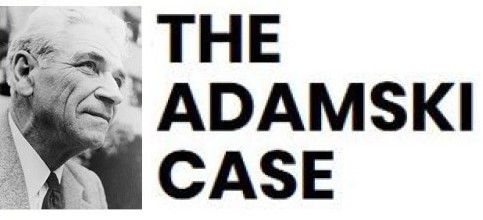When George Adamski — A Herald for the Space Brothers 🔗 was published in 2010 and I was invited to give presentations about my work, to my amazement 80 to 90 per cent of the audiences had hardly or ever heard of George Adamski, and most of those who had only had a faint idea of who he was.
While this is a good indication of the effectiveness of the disinformation campaign aimed at the 1950s contactees in general, and Adamski in particular, and the ridicule and derision of Adamski’s character, motives, and methods that followed, it obscures the massive impact that his mission has had on modern culture. More than anyone else’s, his books and photographs ‘normalized’ the notion of extraterrestrial visitors coming to Earth, even if he wasn’t believed.
FILM
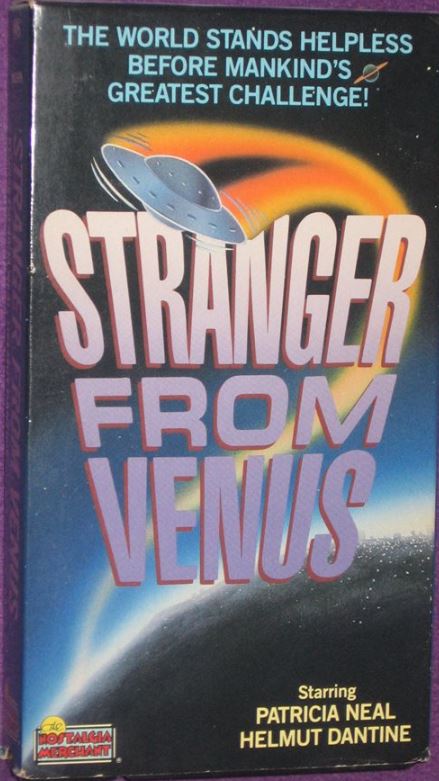
Stranger from Venus (UK) / Immediate Disaster (US) (1954): Written by Adamski’s co-author Desmond Leslie 🔗, originally as a 6-part TV series titled The Venusian. Produced on an extremely low budget, showing almost only people talking, in just three different settings, the film was never going to be a box office hit, even though it starred Patricia Neal (The Day the Earth Stood Still, 1951). It tells the story of a stranger who arrives at a rural inn amid reports of the sighting of a flying saucer. The stranger eventually explains that he has arrived to deliver a message to the leaders of Earth from his superiors who are on their way from the planet Venus, about the impending danger of the atom bomb 🔗: “Be very careful with this nuclear power thing you’ve just invented. You’re about to become a menace to other planets.” (More info 🔗.) Click the still below to view the film on DIY Tube:

Easy Rider (1969): In one scene in this cult hit film of 1969, Billy (Dennis Hopper) tells his companions Wyatt (Peter Fonda) and UCLA lawyer George (Jack Nicholson) how he just saw a UFO, to which George replies with an expose that could have come straight from one of George Adamski’s books:
Screenwriter Terry Southern, who worked on the script with Fonda and Hopper, describes the origin of the scene: “The woman we employed to type the script had just come from Washington, D. C., where she had been an active member of a saucer-cult, founded by the late Adamsky [sic] – whose disciples claim to be in touch with Venusians. (…) Her attitude toward their presence was one of such total conviction, and her enthusiasm so fervent, that it had a very appealing effect. I recorded several of these soliloquies, had a transcript made of the tape and gave it to Hopper, along with the script, before he went on location — where the sequence in question was filmed.” (Source: Terry Southern, letter to the New York Times books section, 7 June 1970 )
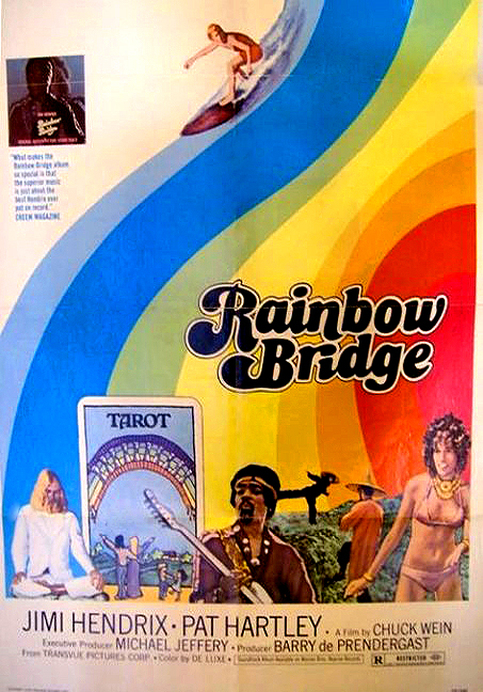
Rainbow Bridge (1971) is the registration of a ‘New Age’ gathering on Maui, Hawaii, in 1970, where Jimi Hendrix played one of his last concerts. Near the end of the film former Adamski co-worker Charlotte Blob speaks about Venusians who have secretly contacted the US government and offered a free and non-polluting energy system, and because that would be a threat to the vested financial and economic powers, the ET presence was covered in secrecy. Ironically, the idea behind Rainbow Bridge 🔗 was “to shoot an antidote to Easy Rider, showing the positive side of the youth movement.” (Harry Shapiro, Jimmy Hendrix: Electric Gypsy, 1990)
According to Les Potts, who was involved with the production of the film, director Chuck Wein “wanted to produce a program to relieve mass paranoia against the arrival of extraterrestrials”. (‘Remembering Rainbow Bridge‘, 2010)
LITERATURE
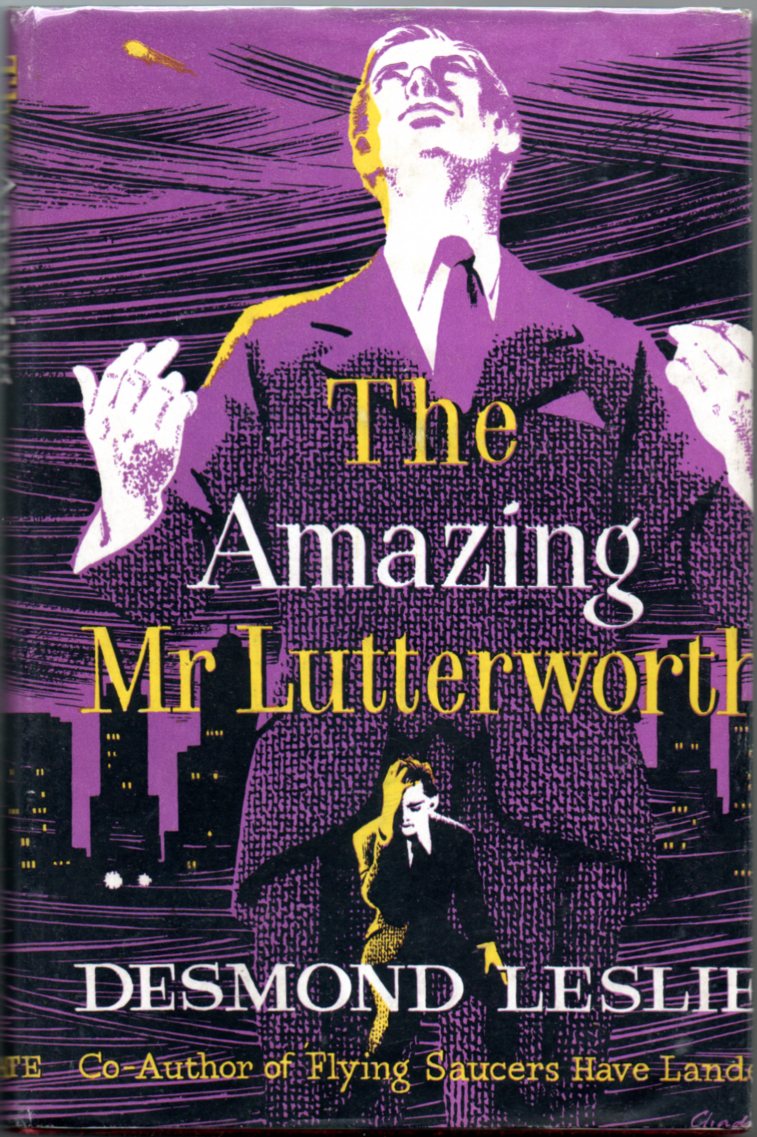
In addition to Flying Saucers Have Landed, and the script for Stranger from Venus and three other films, Desmond Leslie wrote five novels and two satires. About his 1958 novel The Amazing Mr Lutterworth 🔗 he said that it “was 75 per cent non-fiction … and the principal character of the plot was, of course, George Adamski.” Published in hardcover and paperback editions, the fictional story follows Mr Lutterworth as he tries to remember his mission to save humanity from the consequences of corporate greed by providing all the nations of the world with an extraterrestrial device for the production of unlimited energy. The story is interspersed with matter-of-fact references to the cosmic philosophy of Universal Law as expounded in Adamski’s teachings.

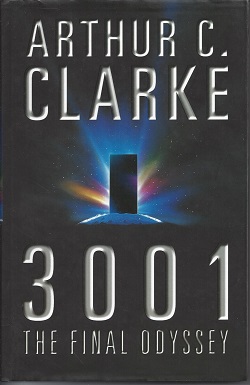
In his novel 3001: The Final Odyssey (1997) British science and science fiction author Arthur C. Clarke refers to ufologists as people suffering from “Adamski’s Disease”, apparently unaware of the abundance of evidence that corroborates much of his teaching and information 🔗.
GRAPHIC NOVELS
Adamski’s desert encounter has been turned into several graphic novels over the years. One early one was a French novel titled Le dossier des Soucoupes Volantes by Jacques Lob and Robert Gigi (Dargaud, 1972), which was a literal depiction of the actual account and was also published in Spanish. In 2011 there followed a US graphic novel titled Saucer Country by Paul Cornell and Goran Sudzuka (DC, 2011), which depicts the uninformed general perception 🔗 of Adamski as a fraud.
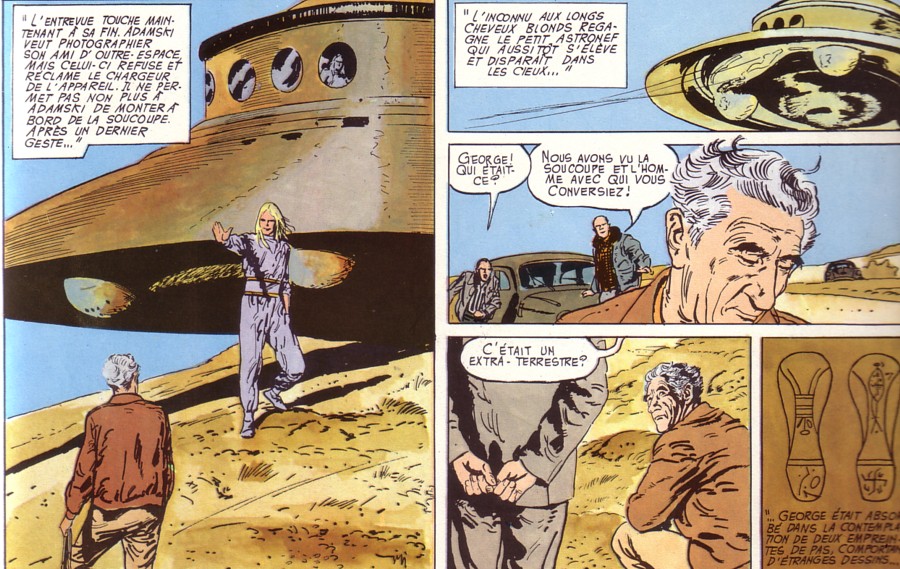
ART
Belgian artist Panamarenko 🔗 (born Henri van Herwegen, 1940-2019) was a prominent assemblagist sculptor and one of the foremost Belgian artists of the second half of the 20th century. In 1970 he started developing models of flying saucers and magnetic space ships and, although he didn’t give much credence to Adamski’s account, in 1982 he built a sculpture inspired by the Venusian scout photographed by Adamski in December 1953, titled Adamski Schotel 🔗 (Adamski Saucer). This was included in a major retrospective at the Royal Museums of Fine Arts in Brussels from September 2005 to January 2006. A silkscreen edition of his design sketch was published in a run of 200 copies. Further editions were printed in 2007 and in 2014. His sculpture Bing the Ferro Lusto from 2002 (right) is also clearly modelled after the Venusian scout ship.

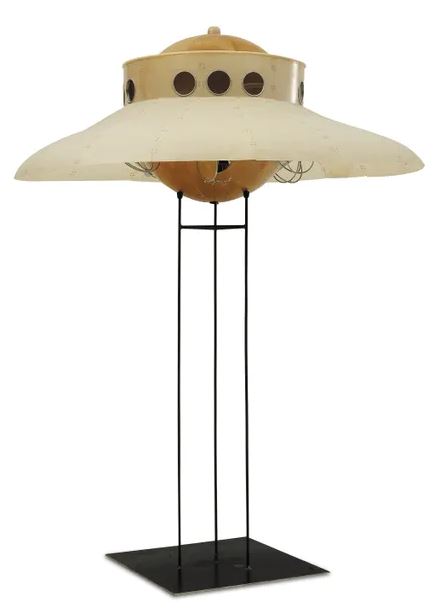
In June 2018 the city of Bordeaux unveiled the artwork that London artist Suzanne Treister 🔗 made for its Bassins à Flot in the Bacalan area of the city, titled ‘Les Vaisseaux de Bordeaux’ (The Spaceships of Bordeaux 🔗), as part of a triptych for the Garonne Public Art Project (2013-2021). The flying saucer, which measures 17 metres in diameter and weighs 13 tonnes, is constructed from galvanized steel and anodized aluminum plates, based on the Venusian scout ship in Adamski’s photographs.

A book by the same title 🔗 accompanies the project.
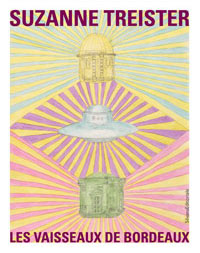
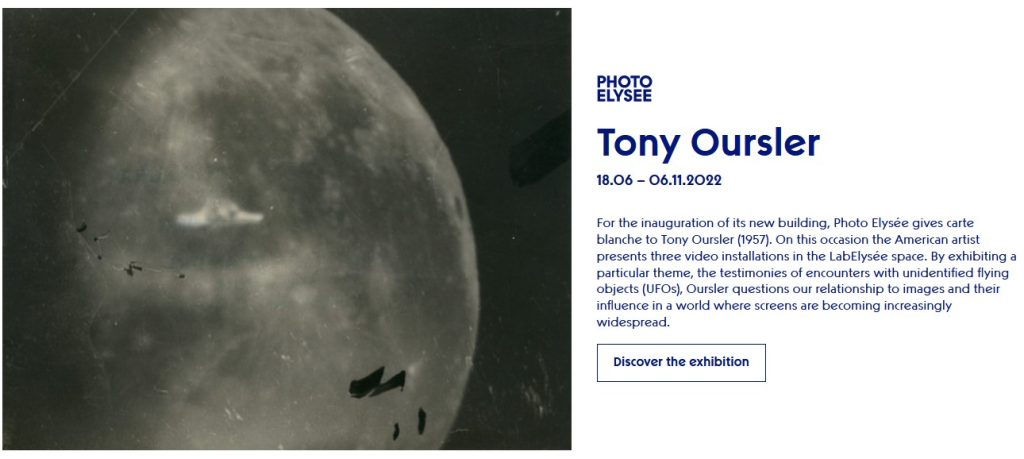
(Image: Photo Elysee/Tony Oursler)
For the inauguration of its new building the Photo Elysee gallery in Lausanne, Switzerland invited video installation artist Tony Oursler 🔗 from New York City, who presented three video installations titled Anomalous 🔗 from 18 June to 6 November 2022. For the theme – the testimonies of encounters with UFOs – the artist drew largely on his own extensive collection of UFO photos. In the text accompanying the exhibition 🔗 Oursler writes: “George Adamski’s photographs of flying saucers invaded the public consciousness and the accompanying popularization of the belief in UFOs generated a unique set of aesthetic and fictive codes parallel to UFO photography such as films books, sound recordings, and lectures.”
MUSIC
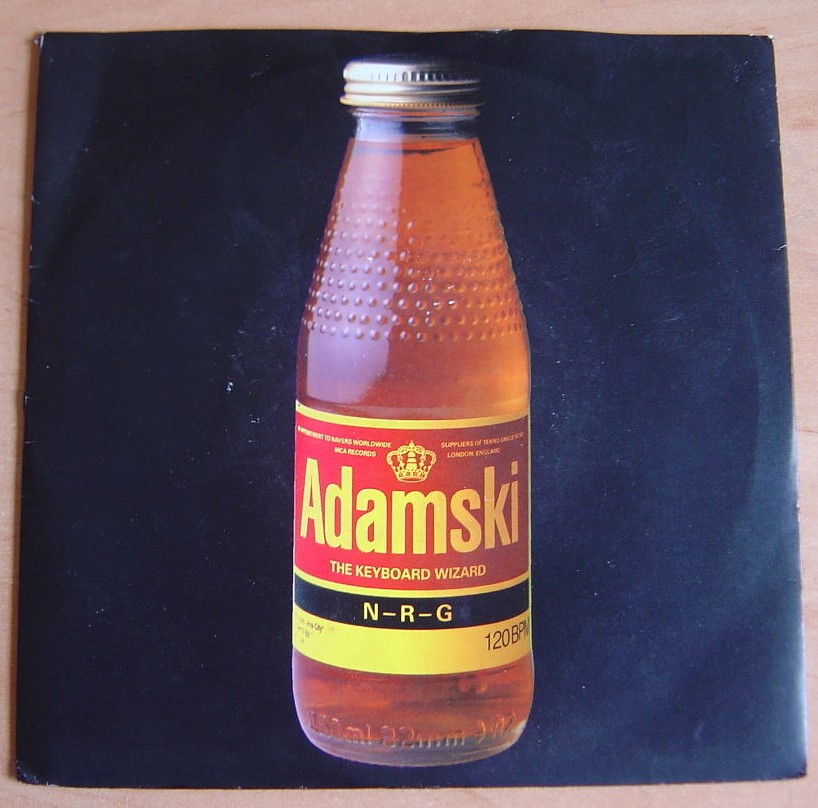
The English DJ, musician, singer and record producer Adam Paul Tinley 🔗, prominent at the time of ‘acid house’ for several tracks and a collaboration with the artist Seal, created his stage name Adamski after George Adamski, and published tracks with titles such as ‘The Space Jungle’ (1990) and ‘Intravenous Venus’ (1998).
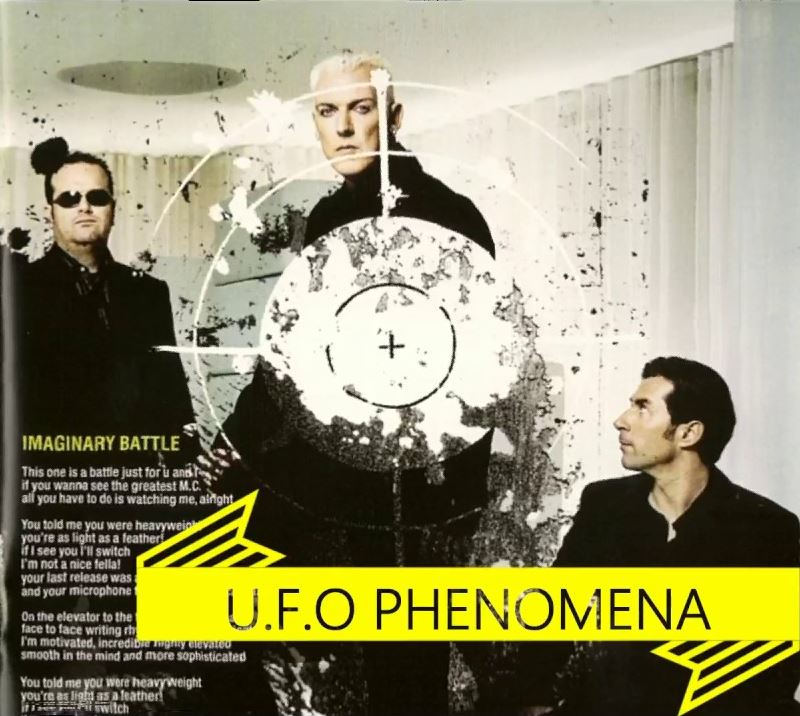
German techno band Scooter refers to George Adamski in their 2007 song U.F.O. Phenomena 🔗. The full lyrics of the track are: “U.F.O. Phenomena / Across the sky like a star / U.F.O. Phenomena / Adamski may have gone too far / U.F.O. Phenomena / On planet earth it’s so bizarre”.
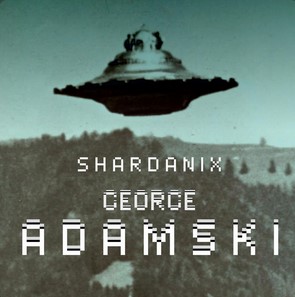
In September 2022 Shardanix, an Sardinian collective of anonymous music producers, released their track celebrating the flying saucer era with a tribute to George Adamski 🔗.
SCOUT SHIP MODELS
George Adamski’s iconic photographs of a Venusian scout ship from December 1953 inspired various model manufacturers.

SCOUT SHIP MODEL KITS
In the last quarter of the 20th century at least four different Japanese manufacturers produced scale models of the Venusian scout ship that became iconic through Adamski’s photographs and films. The last of these model kits (scale 1/60) was marketed as recently as 2000 and included a brief reference on the box to Adamski’s 1952 desert encounter. This model kit was re-introduced in February 2014 for the English speaking market by Atlantis 🔗. Also, in April 2014 a new model kit 🔗 (scale 1/48) was introduced by Hand&Head of Korea.
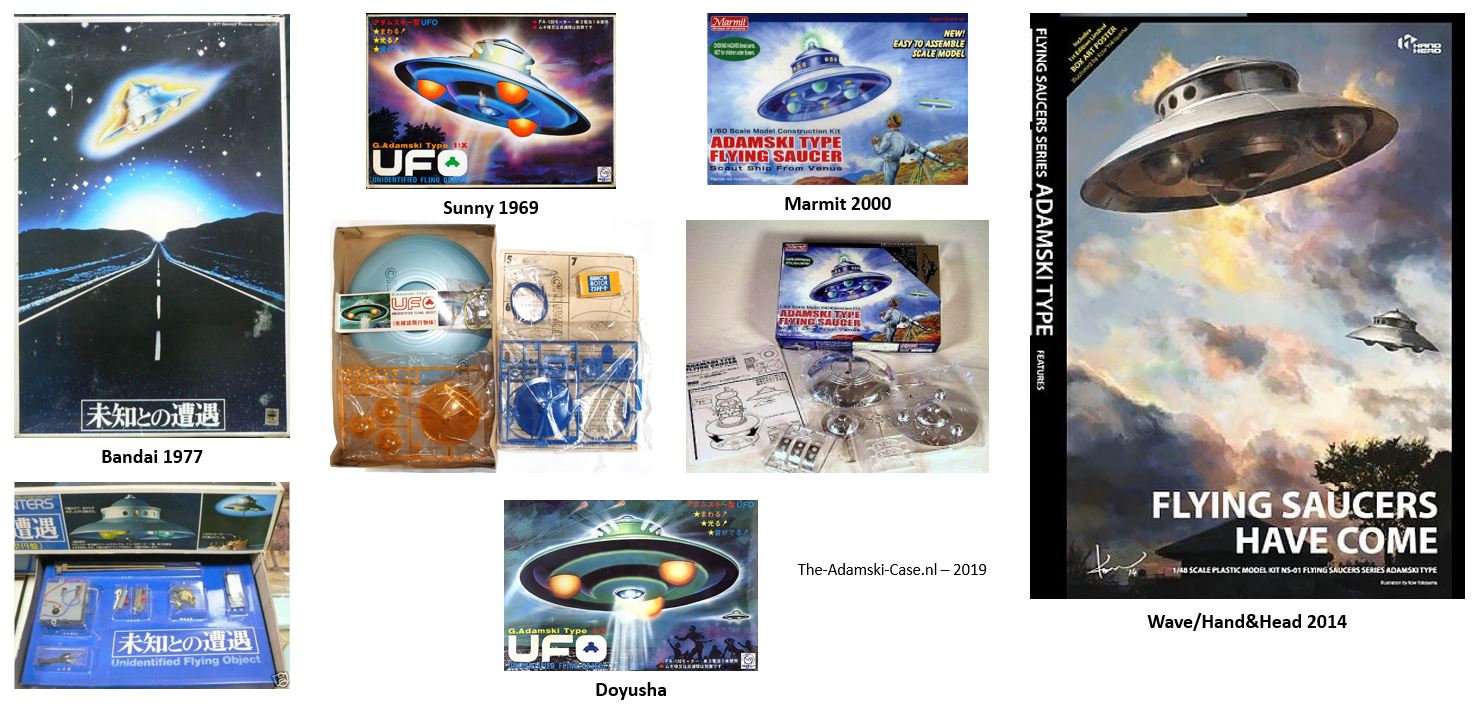
CIGARETTE LIGHTERS
Further evidence of Adamski’s enduring popularity in Japan are two different models Zippo lighters commemorating the 1952 desert encounter.
According to Tony Brunt, Adamski’s Danish co-worker Major Hans C. Petersen “admired Adamski’s balanced personality – the fact that he was a New Age kind of guy but also a red-blooded man’s man” who not only “entertained a deep veneration of the Creator, Nature … his fellow man and … Cosmic Laws,” but also liked a drink and a smoke. In fact, in Inside the Space Ships Adamski describes how, while on a mother ship, “through sheer force of habit, I reached for [my cigarettes]. Observing this, the little lady from Venus smiled and said, ‘You may smoke if you like. I will get you a receptacle for your ashes. You see, only Earth people indulge in that odd habit!’ I thanked her and returned the package to my pocket without taking a cigarette.” (p.65)

VIDEO GAMES
According to the Wikipedia entry on George Adamski 🔗, there are now [2019] six games which use Adamski’s name in some way, mostly based on the prevailing notion that Adamski was a con man. For instance, in a game titled Hunter: The Vigil (2008), Taskforce Valkyrie’s “Operation Adamski works with information. Specifically, disinformation. By spreading around obviously bogus photos and stories through the many madmen on the internet and in the world, ADAMSKI disorients the obvious truth seekers trying to break through the deception.”
Speaking of which . . . see: His reputation 🔗.

POSTAGE STAMPS
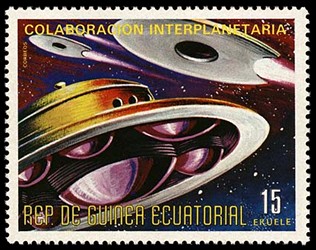
Equatorial Guinea issued a postage stamp in 1974 featuring a flying saucer that was clearly inspired by Adamski’s iconic scout ship photograph, celebrating “interplanetary collaboration”.
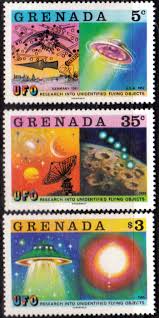
In 1978 Grenada issued these postage stamps, featuring an artist’s rendition of two of George Adamski’s photographs of space craft, the Venusian scout craft (top right), photographed in December 1953; and the formation flying by the moon (centre right) which he photographed 29 May 1950. The series was issued in part as a result of Grenada’s then-Prime Minister Eric Gairy’s effort to organise a United Nations-based committee to research and investigate global UFO reports 🔗. Other renditions illustrate the celestial phenomenon in Nuremberg in 1561, and Washington DC in 1952. Prime minister Gairy was overthrown in a coup in 1978 and his UFO initiative was subsequently dismantled 🔗.
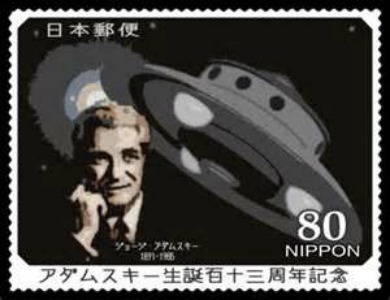
Japan issued a postage stamp that features an artist’s rendition of a photo of Adamski and one of his famous scout ship photos (date unknown).
Other countries, too, have issued postage stamps featuring UFOs, among which the Maldives, Tadjikistan, Tanzania, Turkmenistan, and Kalmykia, whose former President Kirsan Ilyumzhinov 🔗 has famously spoken out about his experience on board a space craft in September 1997.
DOCUMENTARY
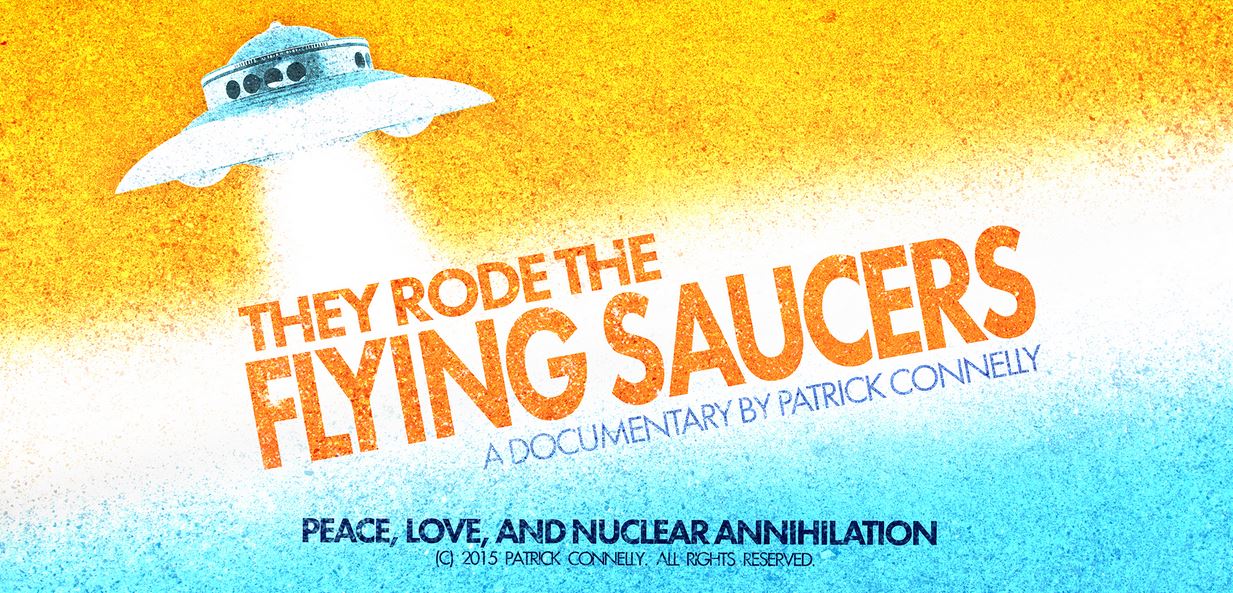
The Venusian scout ship photographed by Adamski features prominently in the announcements for Patrick Connelly’s upcoming film They Rode The Flying Saucers 🔗 (in production), that is set to feature “original audio from the Contactees, original animation, and interviews with Contactees, scholars and authors who discuss how society of mid-century America influenced them, and what impact the Contactees had, even to this day.”
FAIR USE NOTICE: This page may contain (links to) copyrighted materials the use of which has not been specifically authorized by the copyright owner. The Adamski Case publishes (links to) these materials solely for educational and research purposes, constituting Fair Use in accordance with Title 17 U.S.C Section 107 of the US Copyright Law, and Article 5 of the European Directive 2001/29/EC. Please contact The Adamski Case about any copyright or attribution issues.
